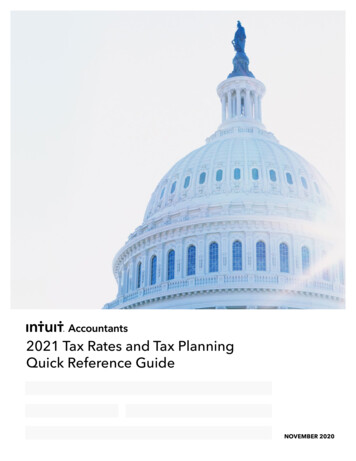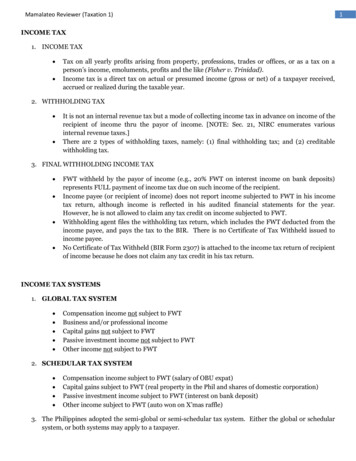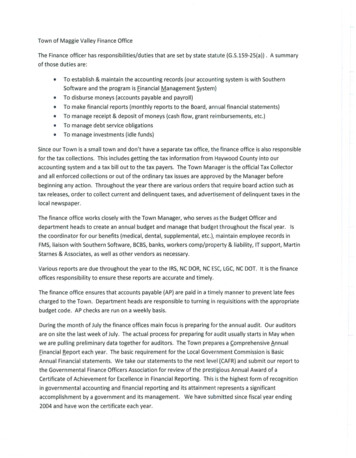
Transcription
TA X R E F E R E N C E L I B R A RY N O 1 0 2Published in association with:Energy4th edition
Energy3 IntroductionChanging times: transfer pricing issues in the oil and gas industryBy Randell G. (Randy) Price and John M. Wells, national transfer pricing leaders – Deloitte oiland gas industry4 O&G BEPS developmentsRelevant BEPS developments and implications for oil and gas industryNadim Rahman and Vitaliy Voytovych discuss how developments with the the OECD BEPS project can impact the oil and gas industry.10 O&G downturnOil and gas industry downturn and transfer pricing considerationsRandy Price, Sam Fletcher and Mayank Gautam explain how a downturn in production for the oiland gas industry and a reduction in the price of oil will impact an energy company’s transfer pricing arrangements.15 TP for bareboat chartersTransfer pricing for bareboat charters in the offshore drilling industryFiras Zebian, Linda Lin, and Joe Wood explain the transfer pricing specifics involved in bareboatcharter related to the offshore drilling industry.20 LNGPrimer on liquefied natural gas transfer pricingSamuel Fletcher, Randy Price and Vitaliy Voytovych provide an overview of the value chain, common methodologies and considerations involved in transfer pricing for liquefied natural gas-relatedcompanies.26 O&G intagiblesThe new black gold: Transfer pricing of intangibles in the oil and gas sectorJohn Wells, Vitaliy Voytovych, and Firas Zebian explain why intangible assets in the oil and gasindustry have become so valuable and how taxpayers can manage transfer pricing compliance ofintangible assets to mitigate their transfer pricing risks.31 Australian LNGAustralian CSG to LNG: A shift from construction to export and beyondJohn Bland, Emily Falcke, and Geoffrey Cann, of Deloitte Australia, explain how the liquefiednatural gas production scene is changing in Australia and what these changes mean for a company’s transfer pricing and international tax operations.36 UK DPTThe UK Government’s new diverted profits taxAengus Barry and Brendan Burgess explain the implications for the global energy and resourcessector when considering the UK’s diverted profits tax.39 People powerPeople power in O&G transfer pricingAengus Barry, Brendan Burgess and Roman Webber assess the mechanism to charge for IP in theupstream oil and gas industry in light of some of the recent base erosion and profit shifting(BEPS) developments.W W W. I N T E R N AT I O N A LTA X R E V I E W. C O M1
8 Bouverie StreetLondon EC4Y 8AX UKTel: 44 20 7779 8308Fax: 44 20 7779 8500Managing editor Ralph Cunninghamrcunningham@euromoneyplc.comEditor Matthew Gilleardmgilleard@euromoneyplc.comJoe ReporterManaging editor, TPWeek.comSophie Ashleysashley@euromoneyplc.comReporter, TPWeek.com Joelle Jefferisjoelle.jefferis@euromoneyplc.comProduction editor João Fernandesjfernandes@euromoneyplc.comOliver Watkinsowatkins@euromoneyplc.comPublisherAssociate publisher Andrew Tappinatappin@euromoneyplc.comOnline associate publisherMegan Poundallmpoundall@euromoneyplc.comMarketing manager Kendred Dovekdove@euromoneyplc.comMarketing executive Sophie Vipondsophie.vipond@euromoneyplc.comSubscriptions manager Nick Burroughsnburroughs@euromoneyplc.comAccount manager James Bakerjames.baker@euromoneyplc.comDivisional directorGreg Kilminster Euromoney Trading Limited, 2015. The copyright of all editorialmatter appearing in this Review is reserved by the publisher.No matter contained herein may be reproduced, duplicated orcopied by any means without the prior consent of the holder of thecopyright, requests for which should be addressed to the publisher.Although Euromoney Trading Limited has made every effort toensure the accuracy of this publication, neither it nor anycontributor can accept any legal responsibility whatsoever forconsequences that may arise from errors or omissions, or anyopinions or advice given. This publication is not a substitute forprofessional advice on specific transactions.ChairmanRichard EnsorSir Patrick Sergeant, The Viscount Rothermere,Christopher Fordham (managing director), Neil Osborn, Dan Cohen,John Botts, Colin Jones, Diane Alfano, Jane Wilkinson, MartinMorgan, David Pritchard, Bashar AL-Rehany, Andrew Ballingal,Tristan Hillgarth.DirectorsInternational Tax Review is published 10 times a year byEuromoney Trading Limited.This publication is not included in the CLA license.Copying without permission of the publisher is prohibitedISSN 0958-7594Customer services: 44 20 7779 8610UK subscription hotline: 44 20 7779 8999US subscription hotline: 1 800 437 99972W W W. I N T E R N AT I O N A LTA X R E V I E W. C O M
INTRODUCTIONChanging times: transferpricing issues in the oil andgas industryBy Randell G. (Randy)Price and John M.Wells, national transferpricing leaders –Deloitte oil and gasindustryn behalf of our Deloitte Touche Tohmatsu Limited tax colleagueswho focus on transfer pricing issues within the oil and gas (O&G)industry, we are pleased to present this collection of papers on industry developments and issues.The O&G industry’s global transfer pricing landscape is in a state ofchange. From a macroeconomic perspective, oil prices have fallen byapproximately 45/barrel over the last year, active drilling rig count isnear a five-year low, thousands of industry jobs have been lost, and thecapital budgets of E&P companies have scaled back significantly.With that list as a challenging backdrop, the O&G industry (as well asthe global tax community) was greeted with what may be considered themost comprehensive changes to the transfer pricing framework in nearlytwo decades as the G20 and the OECD issued proposed new transfer pricing guidelines under the base erosion and profit shifting (BEPS) initiative.The BEPS documentation guidance fundamentally changes transfer pricing considerations for the globally-reaching O&G community and ushersin a new paradigm regarding transparency. In addition, the BEPS ActionPlan states that key changes may be needed in how companies approachthe valuation of intangibles, price risk allocations, and acknowledge orrespect intercompany agreements.Our approach to this guide is to bring some order to this change.Therefore, we begin with a primer on transfer pricing challenges posed tothe O&G industry by the BEPS transfer pricing deliverables. Next, weturn our attention to transfer pricing challenges given the current (andpotentially protracted) economic downturn. Two articles focus on specific industries that are facing challenging environments due to commodityprice deterioration: (i) transfer pricing issues in the contract drilling sector; and (ii) transfer pricing issues in the liquefied natural gas (LNG)space. The final industry article addresses the challenges and opportunities for the O&G industry regarding intellectual property migration. Wehave also included an overview of recent transfer pricing developments forAustralia and the UK, because they appear to be at the forefront of BEPSresponsive initiatives.More information on transfer pricing issues in specific countries andDeloitte Tax contacts locally are contained in Deloitte’s Global TransferPricing Desktop Reference (www.deloitte.com/tax/strategymatrix). We hopeyou find our publication interesting and, more importantly, of practicaluse, and we invite you to contact our leading team of professionals if youhave any questions.OW W W. I N T E R N AT I O N A LTA X R E V I E W. C O M3
O&G BEPS DEVELOPMENTSRelevant BEPS developmentsand implications for oil andgas industryNadim Rahman andVitaliy Voytovychdiscuss howdevelopments with thethe OECD BEPSproject can impact theoil and gas industry.he OECD’s base erosion and profit shifting (BEPS) initiative is aresponse to the growing perception that governments lose substantialcorporate tax revenue due to alleged BEPS activities by many multinationals. In 2013, the OECD developed an Action Plan with 15 keyactions to address BEPS. The OECD then moved promptly to identify theresources needed, propose the methodologies to address the actions, andset deadlines to implement the actions. The key areas of focus of theOECD BEPS Action Plan include transfer pricing transparency and documentation, supply chain structures, financing structures, intellectual property structures, and common tax-efficient cross-border structures. Sincethe OECD is on target to complete addressing the Action Plan by the endof 2015, tax has become an increasingly significant political issue, and several tax authorities are already moving forward on the BEPS agenda independent of the agreement and finalisation of the OECD proposals.While taxation in the oil and gas (O&G) industry is inherently complexand challenging for both the tax authorities and the taxpayer, the new, evolving landscape of BEPS poses more considerations and added nuances forcross-border tax issues. The BEPS Action Plan addresses several key areas ofsignificance to O&G companies in the field of transfer pricing, includingreporting, risk, services, and intangible property, which are discussed below.TNew guidance on transfer pricing documentation requirementsTransfer pricing documentation is poised for the biggest change since theintroduction of US penalty protection documentation rules in the mid-1990s.Under its BEPS initiative, the OECD issued revisions to Chapter V of theOECD transfer pricing guidelines that will significantly increase the type,amount, and transparency of information to be disclosed to tax authorities,resulting in an increased compliance burden on multinational companiesengaged in cross-border transfers of goods, services, or intangible property.Under the new guidance – issued through discussion drafts in 2014 aswell as additional guidance in 2015 – taxpayers will be required to preparethree types of reports: Master file Local file Country-by-country (CbC) reportMaster fileThe master file is designed to serve as a “blueprint” of the taxpayer groupas a whole to allow local tax authorities to understand the context in which4W W W. I N T E R N AT I O N A LTA X R E V I E W. C O M
O&G BEPS DEVELOPMENTSlocal transactions take place. The master file will provide keyinformation about the group’s global operations, including ahigh-level overview of the taxpayer’s business operationsalong with important information on its IP activities, financing activities, supply chain, and overall value drivers.Local fileThe local file is meant to provide information and supportof the intercompany transactions that the local entityengages in with related affiliates. In addition to the information traditionally found in transfer pricing documentation(such as the description of business, description of intercompany transactions, functional analysis, and economicanalysis), the local file should contain details on the taxpayer’s local management structure and reporting structure, acopy of advance pricing agreements and rulings related tothe transaction (even if obtained in a different jurisdiction),and reconciliation of the financial data used in the analysisto the financial statements.Notably, the new guidelines support the use of local comparable companies over regional or global comparables, provided local comparables are reasonably available. Thisrequirement may increase the number of sets of comparablecompanies global O&G companies need to prepare. On theother hand, the new guidelines allow taxpayers to performsearches for comparable companies every three years – ratherthan every year – if the facts and circumstances of the intercompany transaction have not changed significantly.Taxpayers will still need to update financial information of theselected comparable companies on an annual basis.Country-by-country reportOne of the most significant changes came with the introduction of the CbC report. The CbC report is designed to serveas a risk assessment tool for the tax authorities by presentingkey financial information on all group members on an aggregate country basis. Specifically, the CbC report, which provides a heightened level of transparency, is to containinformation on revenues, profit/loss, tax paid and accrued,tangible assets, and number of employees, among otherthings.In February 2016, the OECD released implementationguidance regarding CbC reporting that stated that the CbCreport will be required for years beginning on or afterJanuary 1 2016, and only for groups with global revenuesgreater than 750 million ( 827 million). The report is to befiled annually within 12 months of the fiscal year end.Usually, the ultimate parent company of the group will havethe responsibility to submit the CbC report to its tax authority; however, a “surrogate” parent could be selected insteadin certain circumstances for purposes of filing. The information would then be exchanged among the tax authoritiesusing certain multilateral or bilateral mechanisms.The amount and type of information required to be disclosed would lead to an unprecedented level of globaltransparency. Such transparency may highlight inconsistencies in the company’s transfer pricing policies or the actualresults among similar types of entities, or a disconnectbetween the locations of revenue recognition/profit generation and “value creation”. These changes will call for taxdepartments to have a better handle on global transfer pricing outcomes through regular monitoring of results anddeveloping more in-depth support for their global transferpricing structure.In addition to greater scrutiny of existing transactions,tax authorities will be in a position to focus on broaderaspects of taxpayers’ structures beyond the intercompanytransactions applicable to their jurisdiction. For example,Tax Authority in Country A may argue that the local entity providing what the taxpayer believes to be contract R&Dactivities may in fact be creating significant value inCountry A, and therefore be entitled to a portion of thereturn currently earned by the IP owner in Country B.For multinational O&G companies operating in multiplejurisdictions, the data gathering exercise required to preparethe CbC report may pose a significant challenge as taxdepartments are already stretched thin in the current costcutting environment. Taxpayers are advised to perform a“test run” of CbC report preparation to identify and addressany potential issues related to systems, data accuracy, oraccessibility. Also, such an exercise may uncover potentialissues with transfer pricing policies or results, so performingit well ahead of the filing deadline will give taxpayers achance to address the issues before the data is “broadcast” totax authorities around the world.With regard to the master file, taxpayers that took a decentralised approach to preparing transfer pricing documentationwill likely require a significant change in their transfer pricingcompliance processes to control the preparation of the masterfile. Taxpayers are advised to perform a risk assessment of current intercompany transactions (as well as activities that arenot being documented at present) and a review of currenttransfer pricing documentation scope to ensure they developin-depth and globally consistent support for all material intercompany transfers.Risk allocation and recharacterisation of transactionsIn December 2014, the OECD issued a “Discussion Drafton Revisions to Chapter I of the Transfer PricingGuidelines (Including Risk, Recharacterisation, and SpecialMeasures)” proposing changes to Chapter I of the OECDtransfer pricing guidelines. Subsequent to the release, theOECD received more than 850 pages of public commentsand also held a public consultation. The significant interestwas caused by some of the proposals outlined in the riskdiscussion draft that may impact many taxpayers.W W W. I N T E R N AT I O N A LTA X R E V I E W. C O M5
O&G BEPS DEVELOPMENTSNadim RahmanSenior Manager, Transfer PricingDeloitte Tax LLP225 West Santa Clara StreetSan Jose, CA 95113Tel: 1 408 704 2567nrahman@deloitte.comNadim Rahman is a senior manager with Deloitte Tax in SanJose, CA. He has more than 10 years of transfer pricing experience working in the Texas and California markets, spanning several industries. Nadim has extensive experience working with thelargest oil and gas companies and with several of the largest oilfield services companies. During his tenure with Deloitte, he hasmanaged various projects for large Fortune 500 clients, overseeing projects related to global documentation, headquarter costallocation, intangible valuation, cost sharing, intercompanyfinancing, planning studies, audit defence, competent authorityassistance and APA. He has developed client service relationships with companies in the US, Europe, Asia and Latin America.Nadim specializes in simplifying complex situations for clients,primarily focusing on the energy value chain.The following is an overview of the main points in the riskdiscussion draft and their potential impact on the O&Gindustry, keeping in mind that the final guidance may differfrom the proposal outlined in the discussion draft.Identifying commercial and financial relationsThe risk discussion draft expands the concept of a “transaction”to include situations in which value is transferred although noactual transaction is recorded. An example relevant to the O&Gindustry includes the transfer of know-how through secondedemployees. Such a revision could lead to increased controversyas tax authorities may start identifying transactions where theydon’t necessarily take place. It may be prudent for taxpayers todevelop an in-depth analysis of functions, risks, and contributions of each party to preempt such conclusions.Identification and allocation of riskThe risk discussion draft emphasises that identifying risks is acritical part of a transfer pricing analysis, along with identifying functions and assets. But the allocation of risk betweenrelated parties can be based only on the actual conduct of theparties, and specifically, on their capability to manage andcontrol risk.Under the proposed revisions, risk management includesboth the capability and the decision-making function in thefollowing three areas:6 Ability to make or decline risk-bearing opportunities; Ability to respond to risks as they arise; and Ability to employ risk mitigation strategies.As a result, merely contractually allocating risk, or providing a certain entity a “limited risk” return, may not necessarily be respected unless it follows the allocation of risk basedon the actual risk management activities.The risk discussion draft states that trading a more certain,or lower risk, return for a less certain, or higher risk, return(the “risk-return trade-off) is not a sufficient justification forthe risk transfer. Instead, the document argues that such atransfer should take place only if the transferee is better placedto manage the risk than the transferor. The OECD invited thepublic to comment whether such risk-return trade-off isappropriate under the arm’s-length principle, and receivedfeedback that such trade-offs are based on fundamental economic theory.Nonrecognition and recharacterisationThe risk discussion draft proposes a new approach to determining whether actual intercompany transactions may be disregarded by tax authorities for transfer pricing purposes.Under the new guidance, a transaction should be respectedfor transfer pricing purposes only if it has the “fundamentaleconomic attributes of arrangements between unrelated parties and commercial rationality”. The risk discussion draftsuggests that each affiliate involved in a transaction shouldhave a reasonable expectation to enhance or protect its owncommercial or financial positions, compared to other optionsrealistically available to them. A litmus test would be whetherthe group would be better off on an overall pre-tax basis.The proposed approach is likely to increase uncertaintyand tax controversy, and potentially lead to double tax. Taxauthorities would have more precedent for recharacterising anonrecognised transaction, which could lead to potential documentation penalties.Activities that may be affected by the changes proposed inthe risk discussion draft may include commissionaire or limited-risk distributor entities, contract R&D services, and centralised asset ownership/leasing structures, which arecommon in the O&G industry. For example, a number ofcontract drilling services providers submitted commentpapers expressing concern that the OECD proposals, including under the discussion draft, do not take into account someof the unique characteristics of the sector, such as the criticalimportance of an asset and its specifications, the need for assetmobility that’s realised through centralised asset ownership,and the significant utilisation risks associated with owningsuch assets.Overall, companies may want to consider “stress-testing” their existing structures to identify any potential gaps,and addressing them through ensuring sufficient local substance, maintaining consistency between the letter of theW W W. I N T E R N AT I O N A LTA X R E V I E W. C O M
O&G BEPS DEVELOPMENTSintercompany agreements and actual activities of the parties,and enhancing the support for the current pricing approach.Vitaliy VoytovychDirector, Transfer PricingDeloitte Tax LLPServicesCost contribution arrangementsThe OECD on April 29 2015, released a discussion draft oncost contribution arrangements (CCAs) under Action 8 thatcontains proposed revisions to Chapter VIII of the OECD’stransfer pricing guidelines. Consistent with the current guidance, the CCA discussion draft applies to both service CCAs, inwhich participants share the cost of services, and developmentCCAs, in which participants share the costs and risk of developing property. The CCA discussion draft takes the position thatthe outcome of operating within the context of a CCA shouldbe the same as if the CCA had not existed. Therefore, both initial contributions to the CCA and ongoing contributions mustbe measured by value rather than cost (with an exception forlow-value services). The value of each participant’s contribution is determined by reference to the other chapters of theOECD’s transfer pricing guidelines, in particular Chapter VIfor intangible development CCAs. The requirement that contributions be based on value rather than costs is more limitingthan the current guidance, but aligns with the BEPS ActionPlan and the increased emphasis on value splits. Nonetheless,the requirement to use value rather than cost is the change likely to have the greatest impact on existing service CCAs.Two additional recent developments also affect howMNEs share and allocate services cost. On November 3 2014,the OECD issued a draft pursuant to Action 10 of the BEPSAction Plan that reduces the scope for erosion of the tax basethrough excessive management fees and head office expensesby proposing an approach that identifies a wide category ofcommon intragroup services commanding a very limitedprofit mark-up on costs (low value-adding intragroup services). Second, the US Tax Court on July 27 2015, struck downthe requirement in the 2003 US cost sharing regulations thatparticipants in a qualified cost sharing arrangement sharestock-based compensation costs (SBC). This also affects theallocation of SBC under services regulations, and will have animpact on how US-based MNEs share costs under serviceCCAs as well as development CCAs.Services in O&G industry and BEPS considerationsThe O&G industry has certain practices of its own when itcomes to allocating intragroup services, which makes itimportant to examine intragroup services in light of these discussion drafts.There is a plethora of intragroup services provided withinthe O&G industry that range from engineering and technicalservices to management, administrative, and other operations-related services provided by the corporate headquartersof industry participants. The types of arrangements underwhich intragroup services are provided within the O&G1111 Bagby Street, Suite 4500Houston, TX 77002Tel: 1 713 982 2910vvoytovych@deloitte.comVitaliy is a director in Deloitte Tax’s Houston, Texas transfer pricing practice. He has more than 11 years of experience in transferpricing and economic analysis. Before his career in transfer pricing, Vitaliy was an Economist with a private equity firm, and alsoworked in the IT consulting industry.Vitaliy specialises in the oil and gas industry (oilfield servicesand equipment, exploration and production, drilling, marketing,LNG) but has considerable experience in a number of otherindustries as well, including engineering services, semiconductors, and chemicals. He has extensive experience managinglarge transfer pricing engagements, including US and global documentation and planning studies, advance pricing agreement(APA) negotiations, and audit defence work.industry are not only unique but significant in terms of value.Industry participants often provide the same types of servicesat cost (or cost plus a small markup) to their related partiesand third-party joint venture partners in the context of a jointoperating agreement or a production sharing contract. Thepricing to third parties has often been treated as comparableuncontrolled service prices (CUSPs) to determine relatedparty pricing. However, in the US, the use of CUSP inanalysing such transactions has been challenged in some cases,as the IRS has relied on the services regulations promulgatedunder Treas. Reg. §1.482-9 to compel O&G companies toinclude both stock option expenses and a profit element intheir charges to affiliates, irrespective of whether foreign taxauthorities, joint venture partners, or national oil companieswill accept such charges. At times, the markups required onaudit have been very large.With the proposed modifications for service CCAs still indiscussion form, and any future change expected to conformto final decisions in other chapters, as well as the release onlow-value adding services, taxpayers should keep an open eyeon the evolving landscape. Players in the O&G industry withservice CCAs governed by various local regulations shouldreview the existing terms and conditions to identify potentialdifferences with the CCA discussion draft, in particularregarding sharing “value” instead of “costs”, and also watchout for the consequences of the recent US Tax Court rulingon charging out SBCs in the Altera decision.W W W. I N T E R N AT I O N A LTA X R E V I E W. C O M7
O&G BEPS DEVELOPMENTSIntangible propertyIntangiblesThe OECD on September 16 2014, issued revisions toChapter VI of the transfer pricing guidelines, SpecialConsiderations for Intangibles, as part of the BEPS deliverables. The OECD has adopted a broad definition of intangibles in the revised guidance that defines an intangible assomething (1) that is not a physical asset or a financial asset;(2) is capable of being owned or controlled for use in commercial activities; and (3) whose use or transfer would becompensated had it occurred in a transaction between independent parties in comparable circumstances. Intangibles fortransfer pricing purposes include know-how and trade secrets;trademarks, trade names, and brands; rights under contractsand government licenses, including contractual commitmentto make a workforce available; licenses and similar limitedrights in intangibles; and goodwill and ongoing concernvalue. The following are not considered intangibles under thisrelease: market-specific characteristics (for example, local consumer purchasing power and location savings), and assembledworkforce.The guidance recognises that payment for use of an intangible should be made to the party with legal ownership of thatintangible. However, when another party has participated inactivity leading to the development, enhancement, maintenance, protection, or exploitation of an intangible, a separatetransaction dealing with that activity must also be considered,in that, the legal owner has a transfer pricing obligation to payfor those activities it does not perform. The release furtherstates that compensation for intangibles must be determinedon the basis of ex ante information. In selecting a transferpricing method to value intangibles, the guidance makes itincreasingly likely that the method to be applied as the mostappropriate will be the transactional profit split, the use of discounted cash flow techniques by requiring consideration ofboth parties’ realistic alternatives, or other valuation techniques. Further, the pricing should be based on a functionalanalysis that provides a clear understanding of the MNE’sglobal business processes and how the transferred intangiblesinteract with other functions, assets, and risks that comprisethe global business and factors that contribute to value creation, including specific market characteristics, location, business strategies, and MNE group synergies, among others. Therisk discussion draft provides additional draft guidance on riskand value creation as it relates to any intragroup transaction,including intangibles.Hard-to-value intangiblesThe OECD on June 4 2015, released a non-consensus discussion draft on Action 8 regarding hard-to-value intangibles(HTVI). Intangibles that fall within this category may exhibit one or more of the following features: intangibles that areonly partially developed at the time of the transfer; intangibles8that are not anticipated to be exploited commercially untilseveral years following the transaction; intangibles that separately are not HTVI but that are connected with the development or enhancement of other intangibles that fall within thecategory of HTVI; and intangibles that are anticipated to beexploited in a manner that is novel at the time of the transfer.The discussion draft states that, when valuation of an intangible or rights in an intangible at the time of the transaction ishighly uncertain, and quest
Master file Local file Country-by-country (CbC) report Master file The master file is designed to serve as a “blueprint” of the taxpayer group as a whole to allow










